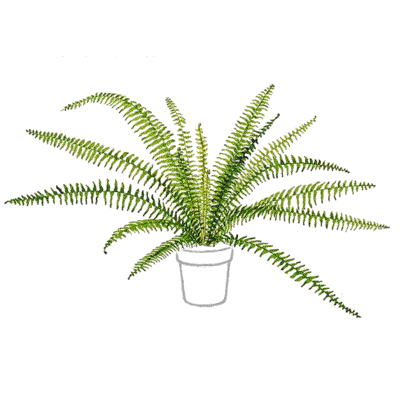

CHARACTERISTICS: Styles in
foliage plants have come full circle since Victorian days with the present
upsurge of interest in the Boston fern, N. exaltata 'Bostoniensis', a widely
acclaimed mutation of the sword fern that was found near Boston in the
1890s and soon became a fixture of the overstuffed parlors of the time,
but has seemed old-fashioned until recently. (The basic species is seldom
grown.) The Boston fern has arching fronds up to 3 feet long with flat
3- to 4-inch closely set leaflets. If the plant is grown on a pedestal,
the fronds can cascade on all sides. The more commonly available dwarf
Boston fern, N. exaltata 'Compacta', has 15- to 18-inch fronds. In addition,
there are a number of mutations with fronds so finely divided that each
resembles a brush, as thick as it is wide. Typical varieties include three
10- to 12-inch types--'Childsii', with overlapping curling leaflets; 'Fluffy
Ruffles', with stiff, densely leaved upright fronds; and 'Verona', with
lacy drooping fronds--as well as a smaller type, 'Mini-Ruffle', similar
to 'Fluffy Ruffles' but only 6 to 8 inches tall, and a larger one, 'Whitmanii',
a lacy arching plant 12 to 14 inches tall.
HOW TO GROW. These ferns do best
in bright indirect or curtain-filtered sunlight; if only artificial light
is available, provide at least 400 foot-candles. Night temperatures of
50° to 55° and day temperatures of 68° to 72° are ideal.
Keep the soil barely moist at all times. Newly purchased or potted plants
should not be fed for six months; established plants should be fed twice
yearly, in early spring and midsummer, with standard house-plant fertilizer
diluted to half the minimum strength recommended on the label. Repot overcrowded
plants in early spring, using a mixture of 1 part loam, 1 part peat moss
or leaf mold, 1 part finely ground fir bark and 1 part sharp sand; to each
gallon pailful of this mixture add 2 tablespoons of bone meal. Otherwise,
use a mixture composed of equal parts of a packaged general-purpose potting
soil and peat moss or leaf mold. All of the ferns described above are sterile--
that is, they are incapable of producing spores, the dustlike reproductive
particles of ferns. However, in spring they send out shoots, or runners,
that root as they creep along the top of the soil and, by early summer,
form new plants that can be cut off and potted. You can also propagate
Boston ferns by dividing the roots of old plants in early spring. Watch
for spider mites, scale insects, and mealybugs.